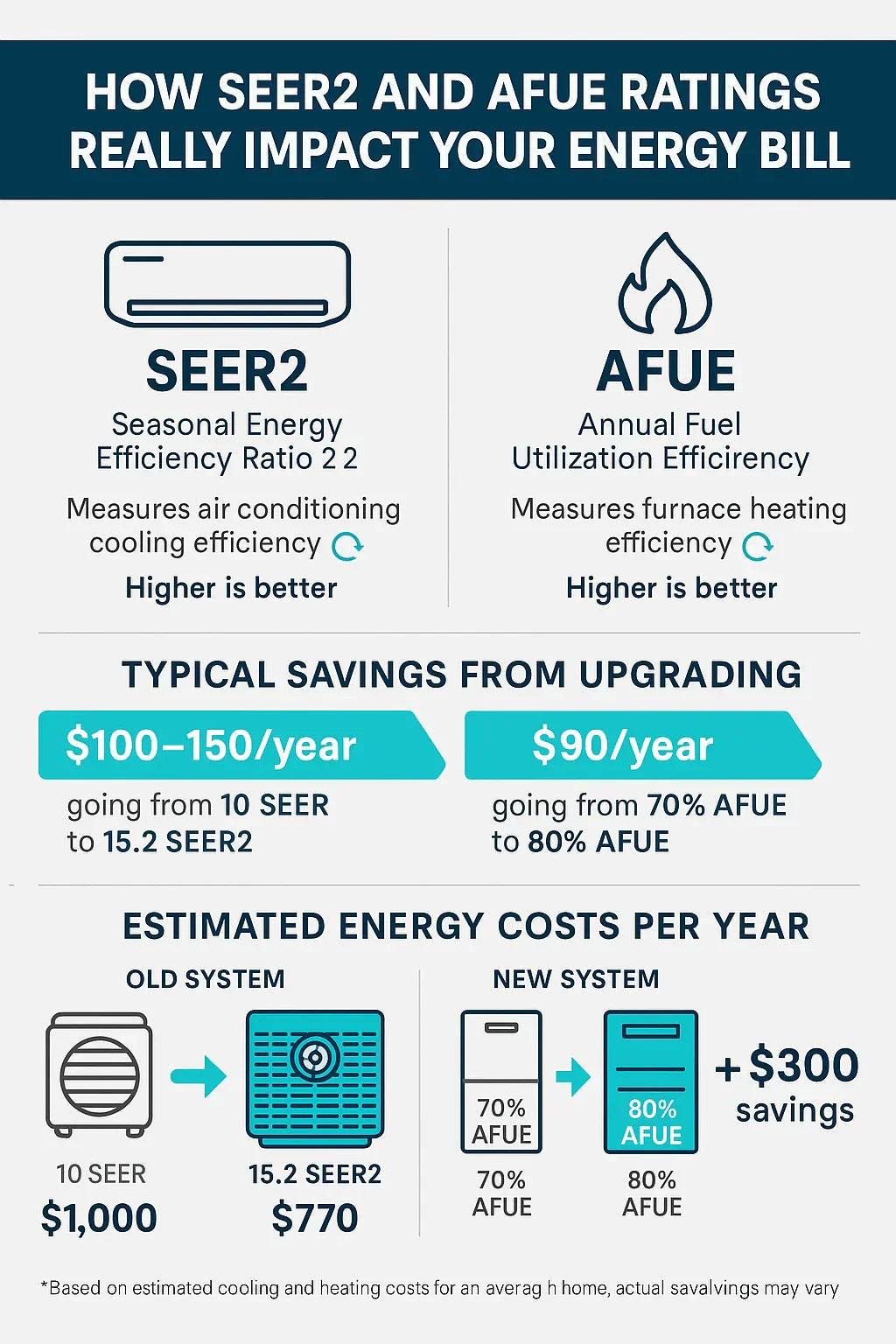⚙️ 1. Why Efficiency Ratings Matter
If you're replacing your HVAC system, understanding SEER2 and AFUE is critical. These two numbers largely determine how much you’ll pay each month to stay comfortable — especially with a combo system like the Goodman 3 Ton 15.2 SEER2 AC and 80,000 BTU 80% AFUE Gas Furnace.
TL;DR: Higher SEER2 = lower electric bills in summer. Higher AFUE = lower gas bills in winter.
❓ 2. What Is SEER2 (and How Is It Different from SEER?)
📏 SEER (Seasonal Energy Efficiency Ratio)
-
Measures AC cooling output per unit of electricity over a season
-
Higher SEER = more efficient AC
🔄 SEER2 (Updated Standard from 2023)
-
Introduced stricter test procedures to reflect real-world conditions (static pressure, ductwork resistance)
-
SEER2 values are ~4.5% lower than SEER
-
15.2 SEER2 ≈ 16 SEER under old standard
🧾 Federal Minimums (As of 2025)
| Region | Minimum SEER2 |
|---|---|
| North | 13.4 |
| South & SW | 14.3 |
🔥 3. What Is AFUE?
AFUE (Annual Fuel Utilization Efficiency) measures how efficiently a furnace converts fuel (natural gas, propane, etc.) into heat.
-
An 80% AFUE furnace uses 80% of fuel for heating; 20% is wasted
-
A 90%+ AFUE furnace uses sealed combustion and a second heat exchanger to reduce waste
| AFUE | Efficiency Description |
| 70% | Low efficiency, older units |
| 80% | Standard for new gas furnaces |
| 90–98% | High efficiency, condensing |
💰 4. How SEER2 Impacts Your Electric Bill
🧮 Example:
-
Mark lives in Ohio with a 1,800 sq ft home
-
Runs AC ~1,200 hours per cooling season
-
Electricity rate: $0.14/kWh
Old 10 SEER system:
-
Estimated usage: 5,000 kWh × $0.14 = $700/year
New 15.2 SEER2 system:
-
Estimated usage: ~3,300 kWh × $0.14 = $462/year
Annual savings = $238
Over 10 years: $2,380 saved — not counting inflation or peak rate hikes.
🔥 5. How AFUE Impacts Your Heating Bill
🔥 Example:
-
Natural gas cost: $1.20/therm
-
Home needs ~650 therms per winter
Old 70% AFUE furnace:
-
650 ÷ 0.70 = 929 therms used → $1,114/year
New 80% AFUE furnace:
-
650 ÷ 0.80 = 813 therms used → $976/year
Savings: $138/year
Higher savings if upgrading to 90%+ AFUE.
📊 6. Case Study: Old vs. New System Comparison
| Factor | Old System (10 SEER / 70% AFUE) | Goodman Combo (15.2 SEER2 / 80% AFUE) |
| Cooling Cost | $700/year | $462/year |
| Heating Cost | $1,114/year | $976/year |
| Total Annual Energy | $1,814 | $1,438 |
| Savings/Year | $376 |
🛠️ 7. Break-Even Point for an Upgrade
Let’s say the total installed cost for a new Goodman combo is $8,500.
-
Energy savings: $376/year
-
Payback period: $8,500 ÷ $376 = ~22.6 years
BUT: Add rebates and tax credits…
-
Federal tax credit (up to $600)
-
Local utility rebate ($200–$1,000 depending on state)
-
Manufacturer rebate (seasonal — varies)
Effective payback could drop to 10–15 years
Plus, add comfort, warranty, and home resale value.
🧠 8. Why 80% AFUE Still Makes Sense for Many Homes
-
Lower upfront cost than 90–98% systems
-
Easier to vent in existing homes (standard metal flue)
-
Ideal for mild climates or well-insulated homes
Unless you live in a very cold region or have high gas costs, 80% AFUE is often the right balance.
✅ 9. Choosing the Right SEER2 and AFUE Combo
| Climate | Suggested SEER2 | Suggested AFUE |
| Hot & Humid (FL) | 16+ | 80–90% |
| Cold & Dry (MN) | 14.3–15.2 | 90%+ |
| Mixed (OH, NC) | 15.2 | 80% |
The Goodman 3-ton, 15.2 SEER2 + 80% AFUE system is well-matched for mixed climates and moderate gas prices.
📲 10. Verified Tools to Estimate Energy Savings
🧾 Final Advice for Mark
“Don’t just look at the price tag. Look at what you’re paying every month — and how SEER2 and AFUE ratings cut those costs.”
Efficiency is your long-term ally. The Goodman 15.2 SEER2 AC + 80% AFUE gas furnace offers an ideal combo of affordable upfront cost and year-round utility savings — especially if you’re upgrading from an older system.
Pair it with a smart thermostat, proper ducting, and regular maintenance, and you’ve got an efficient home comfort setup that pays for itself over time.
In the next topic we will know more about: Cold Climate Ready? How Goodman Systems Perform in Northern Winters







